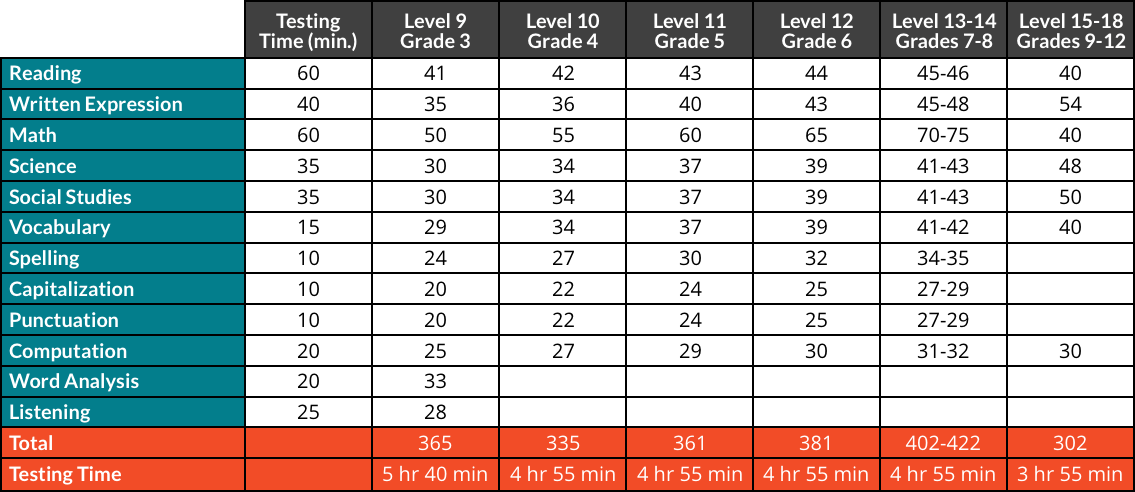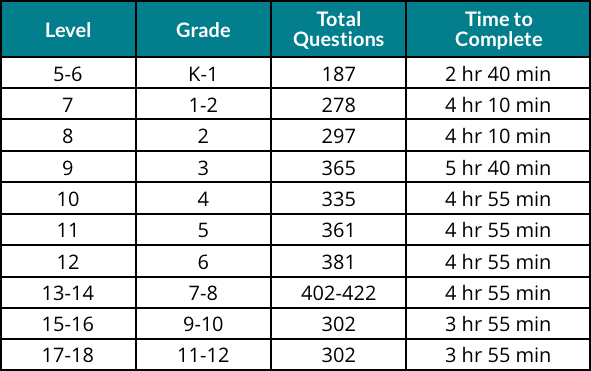The Iowa Test of Basic Skills (ITBS) is a collection of norm-referenced, group-administered achievement tests for grades K-12 that measures a student’s knowledge in subject areas students have learned in school – reading, language arts, mathematics, science and social studies. The Iowa Assessments was released during the 2011-2012 school year and has replaced the Iowa Test of Basic Skills® (ITBS) and Iowa Test of Educational Development®. The new test has been redesigned to better align with the Iowa Common Core Standards. The test is also better aligned with other state standardized tests such as the Smarter Balanced Assessment.
Watch our video to learn more about Mercer Publishing’s ITBS® Test.
The ITBS test includes 10 core sections – reading, writing, mathematics, science, social studies, vocabulary, spelling, capitalization, punctuation, and computation. At the 3rd grade level and below, two additional subtests are given in word analysis and listening. The number of total questions on the ITBS test ranges from 270-340 depending on grade level. Administration time for the full set of subsets at grade level, ranges from 3-3½ hours.
For more information about the ITBS test, visit our Frequently Asked Questions page or our Sample Questions page to see the types of questions that appear in each section of the test.

The best way to prepare for the ITBS test is by exposing your child to the test format and the types of questions they will see on the day of the test. Each full-length ITBS practice test has over 300 questions to practice and comes with answers and explanations. Downloadable versions of our tests are available for Mac and PC users for instant access.
The Iowa Test of Basic Skills (ITBS Test) is used by school districts to assess a student’s college and career readiness. They are also becoming more prevalent as a component of determining whether a student will be admitted into a schools Talented and Gifted Program (TAG or GATE program).
The levels of the test go from 5 through 18 and are associated with the grade levels in the chart below:

In the 2011-2012 school year Houghton Mifflin Harcourt replaced the Iowa Test of Basic Skills (ITBS) and the Iowa Tests of Educational Development with the newly designed Iowa Assessments.
The new design was implemented to more closely align with the Common Core State Standards. New research was also completed to connect students' performance on the Iowa Assessments to their performance to the ACT exam. This allows Iowa Assessments scores to serve as an indicator of a student's readiness for college.
Many schools rely on standardized test scores to place your child in the best programs. It is, therefore, highly beneficial to make sure that your child understands what each of the test areas is asking for ahead of time.
Children who are familiar with the test format and who have had practice with the types of questions on the test tend to experience less test anxiety and preform better than children who are unsure how to approach the questions.
Our full-length practice tests for the Iowa Test of Basic Skills are in the same format as the actual exam. With our practice tests your child will become familiar with how the tests are formatted, the symbols used, and the number and types of questions in each subject area. This helps insure that students know what each subtest expects of them and how best to approach the items.
The official guidance from the test publisher is that students should not guess if they do not know the answer to a question – that random guessing compromises the validity of the scores. However, a student's ITBS scores are calculated based on the total number of right answers and the student is not penalized for incorrect answers. Therefore, as parent or teacher hoping to improve student performance, it is better to advise children to answer every question, even if they have to guess, than to leave answers blank.
The ITBS can be hand scored by school personnel or machine scored. A student's performance on the ITBS is compared with the performance of a nationally - representative sample of students who took the test (the norm group). One ITBS score that reflects this comparison is called a national percentile rank (NPR). If a student’s national percentile rank in reading is 62, then the student scored as well as or higher on this subtest than 62% of their same-grade peers in the national norm group. Percentile ranks range from 1 to 99. The national average in all subtests is the 50% percentile.
Other scores received from the ITBS may include:
Score reports generally contain a narrative that helps with understanding and/or interpreting the score results.
The ITBS covers the following 10 subject areas: Reading, Written Expression, Mathmatics-Concepts and Estimation, Science, Social Studies, Vocabulary, Spelling, Capitalization, Punctuation, and Mathmatics-Computation. At grades 3 and below two additional sections, Word Analysis and Listening, are also included in the test.
For a more in-depth description of the ITBS, utilize our Frequently Asked Questions page to answer any questions you may still have.
In the Reading Section, students are given a passage to read followed by several multiple choice questions about the passage. The student must read the passage then answer each related question by selecting the response choice that best answers the question.
Lucy was no ordinary girl. She had been born with a special gift, a gift other people considered to be unusual. When she was only 3 years old her parents noticed she had a special way with animals. She loved animals and the animals that she came into contact with were especially attracted to Lucy.
Choices:
In the Written Expression Section, students are tested on their writing skills, including - sentence structure, grammar and usage, verb tense, and punctuation.
There are two types of items in this section. The first type of item is similar to those included in the Reading Section. Students are given a passage to read followed by several questions about the passage. In the Written Expression Section, the passage contains numbers to identify sentences and underlined portions to identify words or short phrases within the passage. Students should select the response choice that best answers the question.
Sample item (Type 1):
q My brother’s name is Jason. w He is 5 years old. e Jason likes to pretend he is a super hero. r He keeps a red cloak and a black mask under his bed. At any time, he might run to his room, scramble under his bed and grab them. t The next thing you know, Jason dressed like a super hero, dashing around the house in his shiny outfit, pretending he can fly!
Sample item (Type 2):
The second type of item in this section asks students to find the mistake in a brief passage or sentence. If the passage contains no errors, the student selects (No mistakes).
In the Mathematics-Concepts and Estimation Section students are given math problems that test their understanding of numbers and math concepts. Some questions include a picture or diagram that students must use to answer the question.
Sample question:
Choices:
In the Science Section, each question is designed to test a student’s understanding of science. Students must choose the best answer for each question.
Sample item:
Choices:
In the Social Studies section, students are tested on their knowledge of social studies. The Social Studies section is divided into 4 sections, Civics/Government, Geography, History, and Economics.
Sample item:
In the Vocabulary Section, students are tested on their word knowledge. Each item has a short phrase with one word underlined. Students must determine which of the available response options has the same or almost the same meaning as the underlined word.
Sample item:
In the Spelling Section, students must look for words that are not spelled correctly. Each item has four words and an option that says (No mistakes). If any of the first four words is misspelled, the student should mark the letter that corresponds to that word on the answer sheet. If none of the words are misspelled then the student should select the option that says (No mistakes).
Sample item:
In the Capitalization Section, students are given a short passage or sentence and asked to determine if there are any mistakes in capitalization. If the student finds an error in capitalization, they mark the letter that corresponds to the line that has the capitalization error on the answer sheet. If the passage has no capitalization errors then the student should select the letter that corresponds to the line that says (No mistakes).
Sample item:
In the Punctuation Section, students look at a short passage and determine if there are any mistakes in punctuation. If the student finds an error in punctuation, they mark the letter that corresponds to the line that has the punctuation error on the answer sheet. If the passage has no punctuation errors then the student should select the letter that corresponds to the line that says (No mistakes).
Sample item:
In the Computation Section, students are given math problems that test their ability to solve equations. Each list of response options includes an answer choice that says “N”, which means the correct answer is not given.
Sample item:
Choices:
In the Word Analysis Section, students are given part of a word and a picture. Students are asked to choose the answer that correctly completes the word.
Sample question:
Choices:
In the Listening Section, an adult reads the stories and the questions aloud to the student. Items are designed to test a student’s listening skills. After listening to the story and the related question, the student must select the picture that best answers the question.
Sample item (read by adult):
Jimmy loved to run races. He competed in many cross-country races and at the age of only 9 he won his first gold medal in a 5 mile race. His parents were proud of Jimmy, not just for winning, but for having such a passion for his sport.
Iowa Assessments™ is a trademark of Houghton Mifflin Company. Iowa Assessments™ is owned and published by Houghton Mifflin Company. Houghton Mifflin Company was not involved in the production of, nor endorses, this practice test.